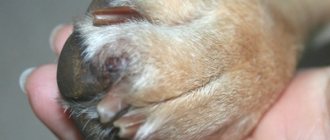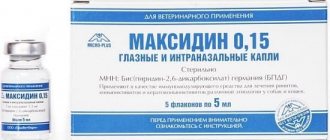Today we’ll talk about paralysis in dogs. I don’t even want to imagine how people feel who are unable to walk, satisfy banal human needs on their own, or enjoy all the delights of a full life. A disproportionate feeling of powerlessness prevails when looking at people with disabilities. At the same time, our smaller friends and life companions - animals, are not without the risk of finding themselves in the same difficult situation of helplessness.
They may also be susceptible to diseases that paralyze their limbs. The overwhelming majority of veterinarians often throw up their hands in front of such patients, refusing to treat paralysis in dogs, only consoling the owner with a hint of a humane outcome. Indeed, the topic is quite sensitive and morally binding. You can understand it only if you are informed and rely on theoretical foundations. However, of course, this is only one percent that makes up the proper care of such animals.
Causes of paralysis in dogs
Veterinarians usually identify the following causes of paralysis in dogs:
- The animal receives severe injury followed by the development of partial or complete paralysis of the body. Head injuries need to be considered separately. Even “simple” blows are extremely dangerous, as they are fraught with hemorrhages into the subarachnoid cavity (as a result of which hematomas are formed). The blood compresses the nervous tissue, which disrupts the normal functioning of the brain, which leads to the development of paralysis. In addition, any damage to the brain is fraught with problems in the future. So, after paralysis, a dog may “suddenly” develop epilepsy.
- Infectious diseases. Almost any viral pathology is dangerous, since its causative agent can pass through the blood-brain barrier and damage the brain (or spinal cord).
- Meningitis and encephalitis of any origin.
- Concussions and contusions.
- The damage is not to the brain, but to the spinal cord. This is especially true for old animals. They often develop degenerative pathologies of the skeleton and spine. In particular, arthrosis, herniated discs, etc. Due to these diseases, the roots of the spinal cord are compressed, their atrophy develops, which leads to paralysis.
- Poisoning , especially when neurotropic poisons enter the body.
- Neoplasms in the brain or spinal cord.
- Heart attacks, strokes (they happen in dogs too).
Neurological examination
Neurological examination includes:
- collecting a history of the dog’s life;
- establishing the time of onset of paralysis (less than 24 hours, more than 24 hours ago, more than 48 hours);
- assessment of the mental status (degree of consciousness) of the patient;
- assessment of motor activity, presence or absence of support ability, skin sensitivity, determination of muscle tone, testing of tendon reflexes and assessment of deep pain sensitivity.
Based on the results of the examination, additional research methods may be prescribed, such as radiography, myelography, CT or MRI of the spinal cord, blood tests, virological or bacteriological studies, cytology and biochemical analysis of cerebrospinal fluid.
Symptoms and first warning signs
The first symptoms indicating the development of paralysis in dogs (and it does not matter whether complete or partial):
- Loss of mobility. If a dog, who was previously a lively dog and happily ran around the yard on every walk, suddenly begins to barely walk, he probably needs to be taken to the vet immediately.
- When a dog begins to drag its paws or limp , although this has never happened before and there are no signs of injury.
- "Morning laziness." In this case, the dog cannot get up for a long time, tosses and turns, whines, but its paws do not obey. In addition, even if the dog has difficulty getting up, for the first half hour or hour his gait is “wooden” and stiff, as if the animal is walking on stilts.
- With complete paralysis of a limb or tail, the diseased organ sags and does not function at all. The dog cannot step on the paw, as it immediately breaks, and the tail simply hangs like a rope.
Do puppies have them?
Puppies are not protected from this disease and one can say. They are at even greater risk than adult dogs. Any spinal injury can cause paresis. Puppies are very active and can hurt themselves when playing. Also, severe infectious diseases, in particular plague, can leave behind such complications.
It should be remembered that some breeds have an innate tendency to develop paresis. Due to the special structure of the spine, dachshunds, poodles, basset dogs and French bulldogs often suffer from this disease.
Main types of paralysis in dogs
Some types of paralysis in dogs are relatively harmless and can be treated, while in other cases paralysis indicates functional damage to the brain/spinal cord.
Paralysis of the front and rear limbs
It is not very common for dogs' front legs to fail. In this case, the reasons may be:
- Injuries to the thoracic spine and front legs.
- Encephalitis/meningitis of any etiology.
- Advanced age. At this time, dogs' vertebrae often wear out, which is associated with the risk of pinching and even breaking of the spinal cord roots.
But paralysis of the hind limbs is a very typical pathology. Causes:
- Injuries of the sacral spine and damage to the limbs themselves.
- All the same meningitis and encephalitis.
- Age-related changes, and in this case the breed predisposition is clearly manifested. Paralysis of the hind legs is a sad feature of large breed dogs (the load on the spine is too great) and dachshunds (features of anatomical development).
Partial and complete paralysis
There are partial and complete types of paralysis. In the first case, the dog may lose one limb, the tail, and in some cases paralysis affects half of the body. The partial variety often occurs due to injury.
In complete paralysis, the body may be completely paralyzed, or the shoulder/pelvic girdle may be completely absent. In this case, the causes are often much more dangerous - functional damage to the brain or spinal cord, poisoning, severe infectious diseases that give complications to the central nervous system.
Functional paralysis
Oddly enough, functional paralysis is one of the simplest and most harmless varieties of this pathology. This is the name for paralysis in which a limb cannot function normally, but the nervous system is fine. It happens after severe bruises, falls, and sometimes develops against the background of prolonged stress.
It is believed that this is temporary paralysis, that is, the functionality of the organ is completely restored after the causes are eliminated. But, unfortunately, not in advanced cases.
Peripheral paralysis
Many people believe that peripheral paralysis is damage to the paws or tail (i.e. peripheral organs). But that's not true! In fact, in this case the cause of the pathology is peripheral injuries, bruises, frostbite, fractures, etc. The central parts of the nervous system are completely “functional”! If paralysis is a consequence of lesions of the brain/spinal cord, it is called central.
Paralysis (paresis) of various nerves
A separate group includes paralysis (paresis) of various nerves. In these cases, everything is in order with the muscles, paws and other parts of the body, but not so good with their innervation.
This happens when nerve trunks are compressed, damaged by poisons, tumors, parasites, caustic substances, etc. In many cases, a complete cure is not possible.
Types of paw disease
Paresis is divided into several types, based on the level of damage to the spinal cord and the limbs affected by the disease. Let's look at the types of diseases that are common in dogs.
Paraparesis
With this type of disease, both forelimbs and both hind limbs can be affected. The central nervous system or peripheral is affected.
Tetraparesis
All four paws are affected. Movements become limited, the disease develops due to neurological lesions of various types. These may be complications after:
- acute cerebrovascular accident;
- myasthenia gravis;
- thrombosis;
- neurosurgery and much more.
Hemiparesis
The causes of the disease are the same as for tetraparesis. Only paresis of the upper or lower extremities occurs. Also, hemiparesis can be left-sided or right-sided.
Provoking factors of paralysis
Below are the provoking factors that enhance and stimulate the development of paralysis in dogs. Some of them are the root cause, while others only “push” the emergence of pathology.
From a tick bite
After a tick bite, paralysis occurs, but the tick itself has nothing to do with it. The root cause is blood parasitic diseases, which are carried by these parasites. In advanced cases, they can cause complications in the form of paralysis.
Poisoning
Not every poisoning can lead to the development of paralysis. Typically, this result is a consequence of the ingestion of heavy metal salts, toxins of certain plants, poisons of snakes, insects, or “exotics” into the dog’s body, such as the poisons of shellfish or poisonous tropical fish. As a rule, after the removal of these compounds, the animal recovers and the functionality of the organs is completely restored... But more often the dog dies long before this, from paralysis of the respiratory muscles or fatal functional damage to the central nervous system.
Stroke
Cerebral hemorrhage, that is, stroke, also happens in dogs. Characterized by severe organic brain damage. This pathology is characterized by complete or bilateral paralysis. The condition of animals after a stroke is extremely difficult; complete restoration of functions is almost impossible.
Injury
As we have written many times, trauma is the main cause of many cases of paralysis. Most often this is:
- Severe limb fractures.
- Damage to the spine (especially the thoracic and sacral regions).
- Traumatic brain injuries.
- Gunshot wounds in working and hunting dogs.
- Deep bite wounds, etc.
Difference from paralysis
It will be difficult for a person who is not familiar with the distinctive signs of paresis and paralysis to get ahead of what his dog is facing. In the body of an animal, the processes of these two diseases are almost identical. Paresis, unlike paralysis, allows the dog to move, albeit slowly. We can say that paresis is incomplete paralysis.
Partial paralysis needs to be treated. Otherwise, this will lead to complete failure of the dog’s hind limbs. The disease is often found among pets. The most common cause of paresis of the hind limbs is considered to be diseases of the spinal system. Any injury, even a minor one, can lead to this disease.
Approximate treatment plan for paralysis
Each treatment regimen is unique and is developed by a veterinarian based on the characteristics of each individual case of paralysis.
But still, the general points of treatment are always the same:
- Immobilization of paralyzed limbs . This is done to prevent additional injury and damage to the organ. For this purpose, the paws are tied up, and sometimes plaster or other types of contractures are applied.
- Electrical stimulation. This is extremely important, since without using this technique the animal will inevitably develop muscle atrophy. In addition, in this case, the restoration of nerve fibers occurs much faster.
- Simulators that allow you to speed up the restoration of the functionality of affected organs. The essence of the technique is repeated repetition of the same movements. Note that this method was entirely borrowed from medicine. HAL therapy has proven itself best.
- Physiotherapy . In recent years, the Bobath technique has become increasingly popular, but regular massage also gives very good results.
- Diathermogalvanization. Veterinarians advise using not only a simple saline solution, but also a 0.5% strychnine solution to moisten the electrodes. This technique allows you to very quickly restore sensitivity and rigidity of the muscles of the affected part of the body.
- Novocaine blockades. The best result is obtained using a warm 0.5% solution of novocaine.
- Treatment is complemented by the administration of injectable forms of B vitamins. They are extremely important for the nervous system, and therefore help speed up the recovery of a sick pet.
Separately, you need to dwell on the nutrition of a recovering dog. The diet must contain polyunsaturated omega-3 fatty acids, the source of which is sea fish. It must either be lightly boiled, or simply rinsed with boiling water. In addition, the diet should contain a sufficient amount of high-quality, easily digestible protein. Since choosing such nutrition can be problematic, we recommend using special veterinary holistic specialists.
Breed predisposition
There are several dog breeds that have a special spinal structure. Compression of certain areas of the spinal cord can cause paresis in the animal.
Take, for example, the French bulldog, in the structure of its spine there is a wedge-shaped vertebra. For this reason, representatives of the breed often experience paresis of the hind limbs. Sometimes it leads to complete paralysis.
Dachshunds also often suffer from paresis of the hind limbs. They have a long spine that suffers from intervertebral hernias. This leads to serious illness. Bassets and poodles are also at risk.
Massage and physiotherapy in the treatment of paralysis
The classic method of treating paralysis is massage and physiotherapy. Note that the intensity of both should be determined by the veterinarian, since excessive zeal or insufficiently active treatment will only prolong treatment or contribute to the development of complications.
The simplest and most effective method is regular massage. Do it at least 3 times a day. The main goal is to improve blood supply to the paralyzed organ and prevent muscle atrophy in this place.
The simplest and least expensive method for the owner is irradiation of diseased parts of the body with Sollux lamps or other infrared lamps. The procedure is carried out up to 2 times a day, for 15-20 minutes. Long exposures are undesirable as they can lead to thermal burns.
In the summer, it is useful to take your pet out into the sun in the morning and evening (you should not do it during the day, as this can lead to heat stroke). Acupuncture has proven itself to be excellent, provided that the veterinary clinic has an appropriate specialist.
Symptoms of paralysis of the body, paws, larynx
Everything was fine, the dog woke up, took a walk, and brought its owner home. Suddenly the animal began to stagger and suddenly began to fall to the floor. The pet whines, stretches out its paws, and trembles slightly. This is what the main symptoms of limb paralysis look like. The disease, which affects the entire body, is characterized by a sudden fall and inability to rise.
With the gradual development of the disease, it all begins with the following:
- Coordination is impaired.
- The limb becomes stiff or too soft.
- There is a loss of sensitivity.
- The dog ceases to control the passage of feces. Urine becomes thick and difficult to pass.
- The dog's character is rapidly deteriorating. She tries to retire, snaps at the owner, and is capable of showing unmotivated aggression.
With paralysis of the larynx, it is difficult for a four-legged animal to breathe. The air comes out with a characteristic whistle. The voice changes, becoming more hoarse. When swallowing, muscle spasms and pain occur.
Recovery of a dog after paralysis
Let us immediately warn you that restoring a dog after paralysis is an extremely labor-intensive process and in some cases very long. It is difficult to give specific recommendations: each specific case must be considered by a veterinarian on an individual basis. However, there are still general recommendations:
- Health-improving exercises. By prior agreement with the veterinarian, the owner can perform them with the pet for 10-15 minutes at least 3 times a day. In particular, with the help of soft straps or special supporting devices, the dog is taught to stand and walk again. If the paralysis was caused by relatively minor injuries, even simple exercises will help your pet make a full recovery within a few weeks. When the dog can (albeit not very well) walk independently, it is very useful to take him outside, also using a system of supporting harnesses.
- Swimming. Since many dogs are excellent and willing swimmers, they can be allowed to swim every day in any calm and sufficiently warm body of water. Just 10-15 minutes a day is enough to speed up the healing process several times. In winter, it is also useful to bathe small dogs and large animals in a bathtub, arranging hydromassage using a shower. Of course, you need to use warm water.
- If, due to a severe injury, it is impossible to completely restore the mobility of the limbs, either a kind of “overhead crutches” that fix the limb , or strollers (usually for the hind legs), can be used. Once accustomed to these devices, the dog will be able to move around the house quite normally.
Prevention of the disease
Naturally, it is better to prevent a situation than to treat it later. Once a dog is paralyzed, only the owner can help him recover. However, there are no magical remedies such as vaccinations or pills that can guarantee healing.
Owners of certain long-bodied breeds should be aware that their dogs are at risk. In this case, it is worth understanding that only a balanced diet, vitamin supplements, as well as regular visits to the veterinarian will be the dog’s (and therefore your) priority for life.
Owners must make all necessary provisions to try to reduce the likelihood of risk to a minimum. To do this, you need to monitor your pet, its diet, activity, physical and moral condition, and regularly visit the veterinarian. If you discover health problems or changes in habits that are not caused by a change in life activity, you should immediately contact a specialist. Take the following rules into account and comply with them regularly:
- Get into the habit of checking your dog for ticks after a walk. This is especially true in the spring-autumn period.
- Feed your four-legged dog fresh food, free him from the habit of picking up food.
- Teach your dog to actively react to everything that moves, runs, or flies, including birds and cats, as he may be injured in the process of chasing.
- The most common injury problem results from being chased by a motorcycle or car.
- It is worth considering even such little things as crossing the street in the right place.
Most owners are not that loyal to their pets. Not everyone agrees that the responsibility for pets lies with those who tamed them. Many people agree to live happily with their pets, however, as soon as it comes to illness, they simply refuse to put up with it.
Currently reading:
- Caring for a Dog with Degenerative Myelopathy
- Seven Signs and Remedies for Getting Rid of Fleas in Dogs
- Symptoms and treatment of vertebral discopathy in dogs
- Pinched nerves and subtle symptoms in dogs
What to do if the pelvic limbs rot?
Festering most often occurs from mechanical damage to the skin when the dog moves along a rocky and hard surface. First of all, this problem can arise in kennel dogs and those kept on a chain, even in cold weather.
But you won’t be able to determine the true cause of infection on your own. The dog must be taken to the clinic for examination to assess the extent of tissue necrosis and the spread of infection.
Suppuration is treated with antibiotics in the form of injections and preparations for external treatment.
What it is?
Limb paralysis is a severe form of muscle weakness, resulting in complete loss of mobility in the legs. The condition of a dog with only its hind end paralyzed is called paraplegia, and it is the most common form of the condition.
According to the type of initial disorder in the central nervous system, paralysis is classified as organic, functional, peripheral and central.
The process of paralysis can develop over several months or occur completely suddenly. The whole main essence of the disease is in the broken connection of impulse transmission between the dog’s brain and spinal cord.
Whether this process will be reversible, and to what extent motor activity will return, always directly depends on the causative factor and the promptness of emergency care. And since the risk of spinal cord injury in dogs is much greater than in humans, this problem is, unfortunately, widespread.
Paralysis of all four
In some cases, as a result of damage to the spine in the cervical region, botulism, plague, polyneuropathy or tick-borne encephalitis, a dog can be paralyzed in all four limbs at the same time. This form of paralysis is called tetraplegia.
Prognosis and consequences for leg muscles
The possibility or impossibility of full recovery depends on the reason for which the paralysis of the hind legs occurred. The most favorable prognosis is possible in cases of intervertebral hernia and highly qualified surgical intervention.
If paralysis is a consequence of neurodegenerative processes, speed and, again, professionalism in the assistance provided play a huge role.
In any case, for a loving owner this is not a reason to euthanize the pet. Recovery often takes a long time and requires maximum attention and competent care from the owner. Subsequently, this often pays off with increasingly confident and independent steps of the four-legged friend.
If it is not possible to restore mobility to the paws due to irreversible processes, a specially designed wheelchair will help your friend live to the fullest for several more years.
Treatment methods
In the early stages, the problem can be eliminated using conservative means. Therapy includes:
- Limitation of pet's mobility. He is forbidden to play, run, jump. All training is stopped until the spinal column is completely restored.
- Use of anti-inflammatory non-steroidal drugs. They relieve swelling around the spinal cord and allow you to get rid of excessive compression of nerve fibers.
- Use of painkillers. They are given in both tablet and injection form. Such medications are selected depending on the severity of the pain syndrome.
- The use of medications (for example, Gabapentin) that eliminate neurological manifestations of pathology. They help eliminate convulsions and uncontrollable tail twitching.
- Taking general strengthening medications that provide the body with the necessary amount of vitamins and minerals.
The course of drug therapy lasts on average one month. After its completion, the dog breeder needs to visit the veterinarian again, examine the dog and make sure that his condition has returned to normal. Until this moment, you cannot cancel the doctor’s appointments without permission - this could harm the animal. If the therapy allows you to get rid of discopathy, the pet will be allowed to return to its normal walking and training regime.
If treatment without surgery does not produce the desired effect, the animal will undergo surgery. It is performed under general anesthesia. As part of this treatment, the doctor excises the affected tissue that puts pressure on the spinal cord and replaces the damaged areas of the spine with implants. This operation is not dangerous. After it is carried out, the animal is prescribed a number of rehabilitation procedures aimed at restoring the mobility of the limbs. If they are performed correctly, your pet will be able to get back on its feet in a short time.
Spine surgery is prescribed only for those pets who have not lost sensation in their limbs. If the animal is paralyzed, and more than 48 hours have passed since it lost mobility, there is no point in prescribing such treatment. The dog's chances of recovery are minimal. In such cases, the veterinarian may prescribe supportive drug therapy for the dog. In the most severe forms of the disease, it is recommended to euthanize the animal.
Hernia removal is not performed on representatives of non-chondrodystrophic breeds: dachshunds and Pekingese. This is due to the peculiarities of the development of the presented pathology in such individuals. They do not experience protrusion of the disc substance, as well as rupture of the fibrous ring. Representatives of such breeds undergo surgery differently: compression of the spinal cord is eliminated. Further rehabilitation of such animals is carried out according to the general scheme.
With timely initiation of treatment, both conservative and surgical, the prognosis is favorable. In six months, the four-legged friend will be able to return to his normal lifestyle.
Video: intervertebral hernia in dogs, its treatment and recovery after removal
Stages of the disease
Discopathy is divided into 6 stages, depending on how severe the neurological symptoms are:
- An inattentive owner may not notice stage 1. The animal will reduce its normal range of motion and will avoid jumping. If you try to feel the spine, you will find a painful area - the dachshund will yelp and will not allow itself to be touched in this place.
- Stage 2 differs from the first stage by the swaying of the dachshund’s legs. The animal runs less and less, but if it goes for a walk, you will notice the following: the walking is slow, and the hind legs seem to be poorly obeying the dog, swaying.
- Stage 3 is quite bright. It is at this time that people most often seek veterinary help. The dog loses the ability to lean on its hind legs and only pulls them behind itself. Sensitivity is preserved at this time, which can be checked by pinching the dachshund's paw. Some movements of the limbs are still preserved, there is no complete paralysis.
- Stage 4 means dachshund paralysis. The paws are absolutely motionless, there are no voluntary movements. You can achieve movement of the paw only in response to severe pain - this will be a reflex jerk, which means that sensitivity is still there, but only very deep.
- Stage 5 occurs when the dog stops responding to severe pain. This will mean severe compression of the spinal cord, in which both motor and sensory fibers are damaged.
- Stage 6 is determined during surgery. With it, the spinal cord dies - it softens and can never perform its functions again. Recovery at the sixth stage is impossible.
At stages 1 and 2, the use of a corset is effective, limiting the movement of the dachshund. The corset is made of thick fabric with metal inserts. It will reduce the movements of the dachshund, will fix the spine and support it.
Due to this, the progress of the disease will stop, and the dog’s condition will not worsen. If you catch the disease at the right time, the corset, in combination with drug treatment, will improve the dog’s well-being, eliminate pain and restore mobility.
Signs indicating discopathy
The symptoms of discopathy in dogs are quite eloquent and when they appear, you should immediately contact a veterinarian in order to detect the disease as early as possible. The disease does not manifest itself in any way at the earliest stages; the dog can be sick for several years and still be active and cheerful.
Best Cardiac arrhythmia - what it is and how to treat it
As degenerative changes in the intervertebral discs increase, its pressure on the spinal cord increases. Then discopathy in a dog has the following symptoms:
- When the cervical spine is affected, the dog tries to move its head less, and stiffness of movements is observed.
- With disease of the lumbar-thoracic intervertebral discs, the dog experiences back pain, almost does not sit down and does not allow itself to be petted.
- The back may be unnaturally arched.
- The animal moves on half-bent legs.
- The dog begins to squeal and whine when trying to change his body position.
- The dog tries to limit his movements.
- The dog has a limp on one or more legs.
- The animal has a tense, constrained gait.
- There are convulsions and trembling of the limbs, and in some cases, the tail.
- The dog may experience uncoordinated movements.
- Abdominal tension and abdominal muscle soreness may occur.
- There is increased sensitivity to touch and an inadequate reaction to it.
- In severe cases, if the dog's paws fail, paw paralysis may occur.
If your pet occasionally exhibits the above symptoms, contact your veterinarian as soon as possible, since the success of treatment depends on the stage of the disease at which it began.











